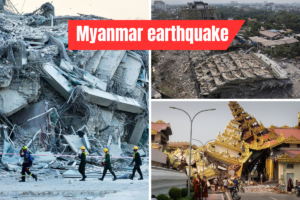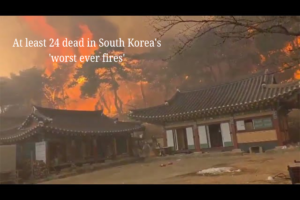Myanmar Earthquake 2025: Nation in Crisis as Death Toll Climbs
The Myanmar Earthquake 2025 has become one of the worst disasters in Southeast Asia, killing over 3,300 people and leaving more than 200 missing. The 7.7 magnitude quake devastated key areas like Mandalay, Sagaing, and Nay Pyi Taw, where collapsed buildings and overwhelmed hospitals highlight the scale of the crisis.
A Nation in Crisis: Myanmar Earthquake 2025 Death Toll Rises
The powerful Myanmar earthquake 2025, measured at 7.7 magnitude, has resulted in over 3,300 confirmed deaths, with more than 200 individuals still missing. Entire communities in Mandalay, Sagaing, and Nay Pyi Taw are devastated, with countless buildings reduced to rubble and hospitals stretched beyond capacity.
For real-time updates, visit the UN Office for the Coordination of Humanitarian Affairs.
International Rescue Efforts Face Obstacles
Emergency teams from China, India, and Russia have joined local responders in an urgent mission to locate survivors and deliver essential aid. The United Nations’ humanitarian chief, after visiting Mandalay, praised community-led efforts but raised concerns about access restrictions imposed by Myanmar’s military regime.
Several human rights organizations report that opposition-held areas are being denied critical supplies, which may worsen the humanitarian toll.
Read more about humanitarian crises in Southeast Asia.
Survivors Found After 60 Hours Amid Rubble
Despite dire conditions, stories of resilience continue to emerge. In Sagaing, four survivors were pulled from a collapsed school nearly 60 hours after the quake. Similar rescues occurred across Mandalay and Nay Pyi Taw, although poor road conditions and damaged infrastructure have made recovery operations extremely difficult.
Explore our blog on how disaster preparedness can save lives.
Military Activity Undermines Recovery
Reports confirm that military airstrikes continued post-disaster, only ceasing after international pressure mounted. This delay in establishing a ceasefire raises ethical questions and complicates the ongoing humanitarian effort.
Learn more about conflict zones and disaster relief.
Shockwaves Across Southeast Asia
The earthquake’s reach extended into Bangkok, where a high-rise under construction collapsed, killing 18 and leaving 76 people missing. The event has raised alarms over infrastructure resilience throughout Southeast Asia.
Check out regional earthquake safety tips.
Anger Rises Over Junta’s Handling of Crisis
Survivors in Mandalay and Sagaing report severe shortages of food, water, and shelter. Frustration is growing as reports surface of decomposing bodies, disease outbreaks, and slow aid distribution. Junta leader General Min Aung Hlaing, after attending a summit in Bangkok, vowed to hold elections—a promise widely doubted by both the local population and the international community.
See our guide on how political instability impacts disaster relief.
UN and NGOs Warn of Health and Food Crisis
With displaced populations growing by the day, aid agencies are warning of a looming health and food crisis. The combination of damaged infrastructure, limited medical supplies, and government restrictions has created a perfect storm for secondary disasters, including cholera outbreaks, malnutrition, and mental health deterioration among survivors.
Looming Health and Food Emergency
The UN and NGOs are sounding the alarm over a growing public health disaster. The displaced population is at increasing risk of cholera, malnutrition, and mental health crises. Aid workers are struggling to reach vulnerable communities due to restricted access and a lack of coordination with military authorities.
What Lies Ahead for Myanmar?
With the confirmed death toll rising daily and hundreds still buried under rubble, Myanmar faces an uphill battle in recovery. The international community is now debating how best to deliver aid independently, circumventing government-imposed roadblocks.
- Over 3,300 dead and 200+ missing due to the Myanmar earthquake 2025.
- Rescue operations blocked in opposition-controlled zones.
- Aid efforts slowed by military restrictions and infrastructure damage.
- UN and NGOs warn of a major health and food crisis.
- The quake’s tremors impacted Thailand and other neighboring countries.
The Myanmar earthquake is more than a natural disaster—it’s a humanitarian emergency compounded by political obstruction. As international rescue efforts continue, time is running out to save lives. Coordinated pressure and transparent aid delivery are essential to avert further tragedy.






